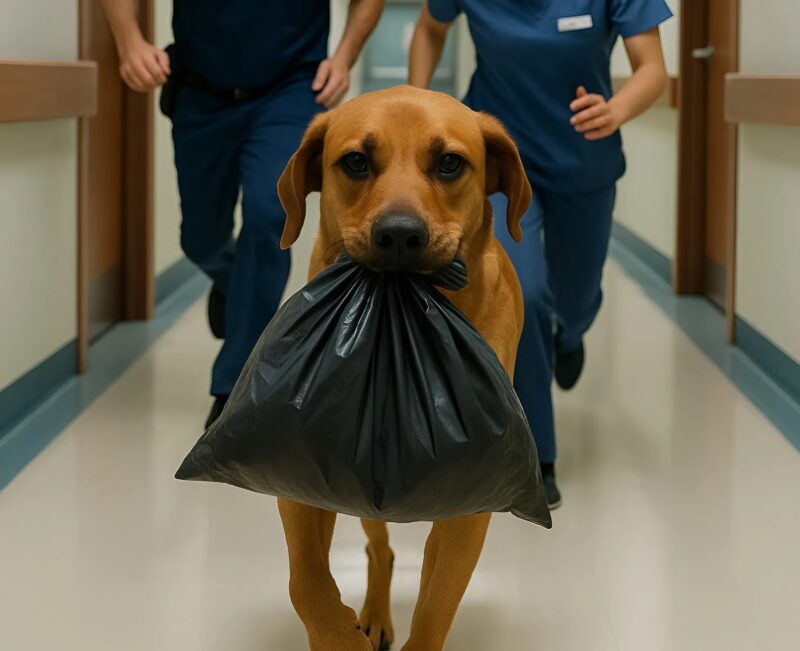It was just another Tuesday morning at Saint Helena General Hospital.
The fluorescent lights buzzed overhead, patients shuffled papers in the waiting area, and the usual lull of beeping machines and muted voices filled the corridors. Head nurse Miriam Callow was reviewing the day’s surgical roster at the front desk, sipping lukewarm coffee and squinting through her glasses.
Nothing out of the ordinary.
Until she heard it.
Click-click-click-click.
Rapid footsteps. Not shoes.
Claws.
She looked up. Around the corner at the far end of the corridor, a flash of reddish fur streaked into view.
A dog.
A large, ginger-brown mutt, lean and muscular, its ears pinned back, eyes focused straight ahead. In its mouth, it clutched a black nylon bag, tightly knotted at the top.
“What in the world—?!”
Miriam stood up so fast her clipboard hit the floor.
“That’s a stray! Get it out of here! It’s unsanitary!” she shouted. “Someone stop that dog!”
Two medical staff nearby—Dr. Keane, a trauma surgeon, and Sofia, a night-shift nurse on overtime—snapped into motion, instinctively chasing after the animal.
But the dog was fast. Too fast.
It ducked past startled patients, skirted around carts and gurneys, and ignored every startled cry and panicked attempt to block its path.
It didn’t hesitate.
It knew exactly where it was going.
Down the main corridor, past Pediatrics, past Imaging, past the cafeteria entrance—until it stopped suddenly at a door with a red sign:
ICU – DO NOT ENTER WITHOUT AUTHORIZATION.
The dog dropped the black bag on the tile floor, sat back on its haunches, and began to bark. Not wildly. Not playfully. Desperately.
First a low, keening whine. Then sharp, frantic barks.
And then, the scratching.
He stood on his hind legs, front paws clawing at the heavy steel door, tail stiff, body shaking with urgency.
Sofia and Dr. Keane finally reached the animal, panting and bewildered.
“Jesus, how did it even get in here?” Dr. Keane muttered.
“I don’t know,” Sofia replied, her eyes falling to the black bag now lying on the floor. “But… this looks like a cooler bag. One of those portable ones used for… samples?”
She bent down cautiously and unzipped it.
Inside was a tightly wrapped package. Cold packs surrounded it. There was a slip of paper taped to the outside of the inner wrap, with the hospital’s name scribbled hastily and a patient ID.
Dr. Keane leaned over her shoulder and read it aloud.
“Patient: Henry Callow. Liver Tissue – Urgent Biopsy Sample. From: Dr. L. Murphy, Redwood Clinic.”
Miriam had just arrived, having followed the commotion. At the sound of the name, she went pale.
“Henry Callow… that’s my nephew,” she whispered. “He’s in the ICU. Liver failure. They were waiting on a same-day biopsy from a specialist downtown, but the courier was delayed…”
Everyone looked at the dog.
The ginger mutt sat quietly now, panting lightly, eyes fixed on Miriam. His tail gave a single thump against the tile.
Sofia’s voice was barely audible. “That courier never made it. This dog… he brought it.”
—
Later, they pieced the story together.
Dr. L. Murphy, a liver specialist at Redwood Clinic 12 miles away, had taken the biopsy early that morning. The hospital’s courier service had been double-booked and delayed. Henry’s condition was deteriorating fast—he didn’t have hours to wait.
And then Dr. Murphy had remembered the dog.
Bruno.
A stray he’d adopted years ago. Loyal, intelligent. A dog he’d trained to carry medications and tools during remote field clinics. Always by his side. Always willing.
He had secured the sample in a chilled black delivery pouch, fastened it around Bruno’s neck, and told him to go—“Go to Henry. Go to the hospital.”
Bruno had done the rest.
Ran through back alleys. Crossed streets. Navigated crowds. Somehow found the hospital and the right hallway, despite never having been there.
Delivered it.
On time.
—
But the miracle turned tragic.
As the ICU staff rushed the sample to pathology, Sofia noticed that Bruno was limping. Then they saw the blood—just a small trail, but fresh.
Dr. Keane knelt to inspect. Bruno’s paws were torn raw. The skin around his chest, where the bag had been strapped, was scraped and bleeding. He was panting heavily. Not from exertion.
From pain.
“We need a vet,” Miriam said. “Now.”
But Bruno’s body had already started to fail.
Sofia sat with him in the hallway, stroking his head gently as he laid it in her lap. His breathing slowed. His eyes, still alert, locked on the ICU door.
The door behind which Henry Callow was now receiving emergency care, thanks to him.
Miriam knelt beside them and whispered, “You saved him.”
Bruno gave one last wag of his tail.
Then he went still.
—
Later that week, Henry stabilized. The biopsy confirmed the diagnosis, and a treatment plan was started. The doctors said that without the sample arriving exactly when it did, he likely wouldn’t have made it.
Miriam had a small brass plaque made and placed just outside the ICU wing. It read:
IN MEMORY OF BRUNO
A hero without words, who ran on faith, and saved a life.
And under it:
“Sometimes, angels have paws.”
